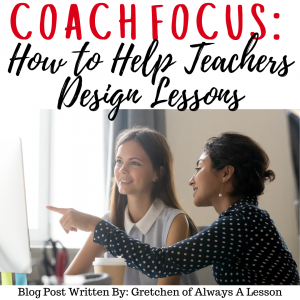Coach Focus: How to Help Teachers Design Lessons
 If you are leading teachers in any capacity, you will want to help them design lessons that are accurate, aligned, and impactful.
If you are leading teachers in any capacity, you will want to help them design lessons that are accurate, aligned, and impactful.
- Accuracy refers to teachers being able to deliver correct information to students in a lesson. They are able to take complex information and break it down into easy-to-understand snippets without losing any accuracy in the facts.
- Alignment refers to teachers being able to locate the appropriate standards to teach while also using those standards to create daily lesson objectives. The internal alignment between the lesson components is essential is designing an effective lesson (ie.standard, objective, assessment, and activities).
- Impact refers to teachers being able to design a learning experience for students that is memorable so that the new knowledge can be easily referenced in the future.
(A recent post for teachers entitled, 5 Tips for Designing a Memorable Learning Experience, is a helpful read for teacher leaders to pass on to those that they support.)
The tips below provide clarity for teacher leaders in how to help teachers design lessons with accuracy, alignment and impact.
Design Lessons with Accuracy
Teachers need to be masters of their craft. The first step is to ensure they are able to internalize the information they are teaching. When they understand the content they teach on a deep level, they are able to deliver it in a variety of ways for their learners. When their understanding is limited, so is the way they deliver it. That means not only will they struggle to deliver accurate information, but they will struggle to say it in a multitude of ways because of their lack of understanding.
Therefore, teacher leaders need to help teachers digest the content they are teaching while providing room for them to collaborate on methods of delivery.
- Prior to a unit, sit with teachers to talk through the major concepts
- Role Play sticky parts by having teachers deliver a mini lesson with the content with you or their colleagues to help build comfortability with the content
- Pop in for informal observations and listen to the words the teacher uses to convey the information
- Share feedback on thorough explanations and/or confusing sections
Design Lessons with Alignment
Many teachers deliver accurate lessons, but their lesson flow can still lack alignment.
Backwards design will help teachers start at the finish line and work backwards to the start line. When they know what they want students to know and be able to do at the end of the lesson, it is much easier to create a learning experience that guides the students towards that end goal. This requires teachers to plan in a new way and build new habits for how to design instruction.
- Run a professional development session on backwards design so that teachers get plenty of practice with:
- Locate the appropriate standards
- Pull key skills out of the standards to create objectives
- Create assessments that determine how well students understand the new concepts
- Plan activities that allow students to grapple with the new content while also working towards the end goal
- Set expectations for how to plan a lesson using backwards design
- Leave examples in the planning room or provide a template to follow
- Provide feedback on lesson plans with specificity on which parts are or aren’t aligned and why
Design Lessons with Impact
Then there are the teachers who deliver accurate and aligned lessons but lack the impact necessary for students to be successful with the new knowledge in other capacities. This means students learn it and do not apply it in other situations or they forget it altogether once it is learned.
Being intentional with how the lesson will impact students’ future success is important. Teacher leaders can help guide teachers through the transformation of just writing lesson plans to actually designing them. This is how a lesson becomes effective.
The questions listed below will help any teacher think through how to maximize the impact of their lesson.
- Will the uniquely designed student experience help solidify the newly learned knowledge or skills?
- Is the lesson material presented so that students do the heavy lifting in thinking and applying?
- Are students making connections without the teacher explicitly presenting them?
- Can the knowledge and skills obtained help students in other disciplines or outside the classroom?
- Will the lesson help students grow as individuals and collectives?
If you need additional lesson planning materials to assist teachers in designing memorable learning experiences for their students, click here.
Teacher leaders, if you need further help supporting those you serve, grab a slot on my calendar to talk it through. Sometimes we need more than just tips; we need specific guidance in the unique situations we are facing. If that is you, don’t hesitate to reach out!
GO BE GREAT!

